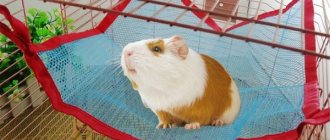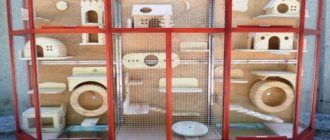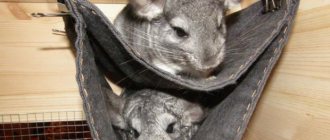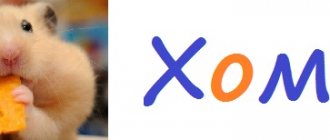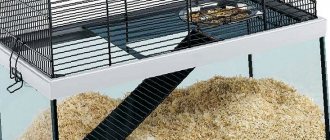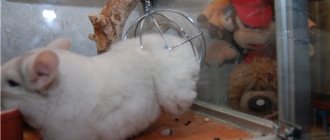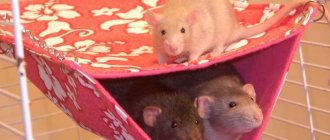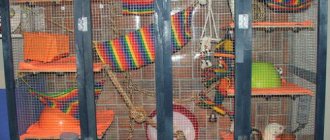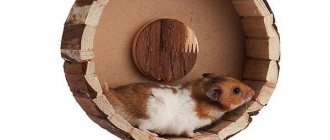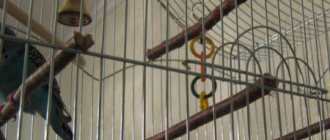The decorative rat is a fairly popular pet. These animals make contact easily, are well tamed, and are loved by both adults and children. In order for a rat to feel comfortable, grow and develop well, it is necessary to create suitable conditions for it. In addition to the feeder and water bowl, the pet’s cage should have ladders, shelves, wheels, houses, and hammocks of various shapes and sizes. Making a hammock for a rat with your own hands is quite simple. We will talk about this in the article.
Types of hammocks
Many rats like to sleep not on the floor of the cage, but on some elevation - this is a requirement of their natural instincts, a tribute to ensuring safety. In addition, such an accessory used by the animal for sleeping allows you to save space on the floor of the cage. Hammocks for small rodents can be of different shapes: traditional rectangular (square), rectangular (square) with a roof, a hammock in the form of a pipe, a hanging house, etc. Some of them are shown in the photo below.
In large cages where several pets live, hammocks of complex shapes, in several tiers, are often hung, as in the bottom photo.
Anyone can make hammocks for rats with their own hands.
Additional accessories for chinchillas
Placing an animal in a new cage is only the first stage of creating a cozy atmosphere for it. In order for a chinchilla to enjoy life, be healthy and active, its place of residence will need to be provided with additional details. What's on this list?
House
One of the mandatory additions to the cage. You can immediately buy a metal cage or a wooden one, or a profile display case with a house. And if you have purchased a display case, or the simplest metal cage, or you want to independently organize a place of residence for a South American rodent, you will need to provide a home for the pet as the main addition. This way the animal can climb into it at any time and rest. The size of the sleeping place is slightly larger than that of an adult chinchilla, because they like to lie down at their full height.
Cozy homemade house for a rodent
Feeder
An essential element of the cage, which is best attached to the bottom or wall of the cage, and should also be washed systematically. There are no restrictions on materials. The most convenient option is a plastic food bowl. The main thing is that it has a comfortable shape for the animal and is moderately deep.
Feeder attached to the cage wall
Drinking bowl
Another important accessory that will need to be attached to the bars of the wall or door. It should always contain clean and fresh water, and the structure itself should not allow leaks. Unlike the feeder, it cannot be placed on the floor, otherwise the water may become contaminated. The breeder can choose one of two common drinker options - ball or nipple.
It is better to attach a glass drinking bowl to a cage
It is necessary to select the one that will be convenient for a particular pet. Another important nuance is that you should not buy a plastic drinking bowl, otherwise the chinchilla can quickly chew through it. The best option is glass.
Sennitsa
She's a feeder with hay. The latter must be present in the chinchilla’s diet to maintain the health of the animal. If you leave hay just like that on the floor, it will soon be naturally distributed throughout the cage. But you should also be careful with the design of the hay feeder. It is best when it is a separate small house. An alternative is to use a small mouse or hamster running wheel that remains closed after the hay is added. The structure will need to be secured first so that the chinchilla does not get hurt.
The best option for feeding hay to a rodent
Stone for chinchilla
It will be needed so that the rodent can periodically sharpen its teeth with its help. Typically, a salt or mineral stone is used for these purposes, which is placed in the same way as a drinking bowl, on the walls of the cells. Otherwise, it may get lost, but it will always be in sight and freely accessible to the pet.
Mineral stone for grinding teeth
Litter tray
Of course, you will need to organize a toilet in the cage, since the chinchilla is a fairly clean animal. Although it was previously mentioned about the need for a pull-out tray under the cage, it is also better to install the tray inside the cage or display case. This will make cleaning much easier and more convenient. Plus, the cage won’t get too dirty or clogged.
For more convenient cleaning and keeping the cage clean, install a chinchilla tray
Sand bath
We have already focused on the cleanliness of chinchillas. In order for them to keep their fur clean, they will need clean sand, as it is preferable to water for animals
A small container is enough, but it should be comfortable for the animal to roll over in it.
Rodent prefers sand baths
Toys
They can be called a sign of a good, caring owner. Moreover, some of them do not have to be purchased at a pet store. What entertainment is suitable for restless rodents?
- Running wheel.
It is better to purchase products made of plastic rather than metal, since such toys are unsafe for chinchillas. A place for active running is installed on the wall of the cage. Wheel for active entertainment - Small tunnels made of plastic.
Pets will be happy with this entertainment. The more interesting the pipe maze, the more interesting it will be for the animal to explore it. - Wooden Toys. In addition to games, the animal will be able to gnaw on it without harm to health.
We recommend hanging a hammock in a cage as a toy and at the same time a place to relax.
Tips for making hammocks
Fans of decorative rats who have already made appropriate accessories for them with their own hands are advised to pay attention to the following nuances:
- The hammock should be quite spacious, approximately twice the size of the animal.
- It should be as harmless as possible, pleasant to the touch and have a neutral odor. The fabric should be soft. It is unacceptable to use metal mesh for rat hammocks. Even though a rat may chew on a fabric hammock, it is better to make it a new one. Metal is too dangerous to be injured, besides, it is hard and cold to the touch. The animal may simply find it unpleasant to be in it, and it will stop climbing into such a hammock.
- The hammock must be securely fastened. If your rat is large, it is advisable to hang it not on strings, but on hooks or carabiners. They can be purchased at specialized hardware stores. Some craftsmen use metal chains instead of ties, but there have been cases when rats got entangled in them and injured their paws.
Of course, hammocks, like houses and other accessories located in cages, should always be clean. This will help prevent the occurrence of many dangerous and unpleasant diseases of your pet.
DIY sennik
Hay placed in a cage simply in a pile will not benefit the health of the pet - the pigs will eat the product contaminated by themselves. To avoid this, it is worth equipping the animal’s home with a hay barn - a special feeder where grass is placed. This device provides the pig with unhindered access to food, but at the same time eliminates the possibility of it being scattered throughout the house.
Pet stores usually sell cages already equipped with a hay box. There you can also purchase a container for hay separately from the cage. There is an alternative option - you can make a hay barn for guinea pigs with your own hands. This does not require material costs and provides complete freedom of creativity.
You can use boxes and other containers as a hay box; even socks and plush toys will do. And from egg trays, as well as paper napkin and toilet paper rolls, you can make a disposable toy haymaker. By placing grass inside these items and giving them to the pet, the owner will delight the pet with new fun, which also contains a nutritional surprise.
A simple haybox made from plastic containers
You can turn a simple plastic container box into a hay feeder. However, any other plastic container will do. The container is secured to the bars of the cage using paper clips. The fastenings should be made higher - this will protect the animals from getting wounds and damage. That's all - the hay barn for the pig is ready. All that remains is to fill it with grass. And of course, we must not forget to add fresh product to this homemade feeder in time.
How to sew a hay bag
To make a hay bag you need:
- Take two pieces of fabric measuring 20x30 cm each.
- Place them right side together.
- Draw two circles on one side in the center (there should be a gap between them).
- Cut out the drawn circles on one piece of fabric to create two windows.
- Finish the edges of the cut out windows with a stitch.
- Sew pieces of fabric along the bottom and side edges, leaving the top edges unsewn.
- Fold in the top edges of the product and finish (stitch) them.
- Turn the product inside out.
- Sew 4 ropes to the upper edges of the resulting bag - two on one and two on the other. Using these ties, the bag will be attached to the bars of the cage.
All is ready. All that remains is to fill the hay bag with food and place the feeder in the pig’s house.
Sennik out of the box
You can make a hay box for a guinea pig from a shoe box or cardboard packaging from small household appliances. Any cardboard boxes will do, the main thing is that they match the dimensions of the animal’s house - the feeder should not fill the entire space of the home. The top and one long side are removed. When removing the side, you should leave 5 mm of cardboard around the edges. 4 holes are pierced on both narrow sides. A wire or fishing line is pulled through them, through which the hay is attached to the bars of the cage. The feeder is ready - you just need to place the product in it.
What can you make a hammock from?
For those who do not like or do not know how to sew, the following tips may be useful. So, what can you use to make the simplest hammock for a small rodent?
For this you can use:
- An old pillowcase or towel, folded in half (four times).
- An old unnecessary hat.
- An old headscarf or neckerchief.
- Unnecessary socks.
- Wool hats that have gone out of fashion.
These objects are simply attached to the corners of the cage at a suitable height, taking into account that the rat can freely get into and out of the hammock.
Next, we will consider options that require at least minimal sewing skills.
Shallow pool
A shallow pool will provide a lot of fun for your rodents in the summer. Cool splashes, a chance to dig around and look for treats!
- Use a heavy flower pot stand or bowl.
- Add some smooth pebbles to the bottom - these can be found in garden stores or aquarium supplies.
- Fill the container with water.
- Scatter some frozen peas or corn under the pebbles.
- Let the rats in.
Your pets will love rummaging through the pebbles looking for treats! At the same time, they will escape the summer heat in cool water.
Hammock tube
Do-it-yourself rat hammocks in the shape of a pipe, like any other, can be sewn from cotton or synthetic fabric. Caring owners sew them double: on the outside - decorative fabric, on the inside - soft fleece, so that the animal feels comfortable touching its surface. However, not everyone has time for intricate sewing.
The easiest option is to take a piece of sleeve from unwanted clothing or cut a piece from old trousers. The easiest way to make a hammock for a rat is from jeans. This fabric is durable, practically does not fray, and the finished product will have an attractive appearance. Strong ribbons are sewn at the corners. They tie themselves to the cage - the hammock is ready.
DIY rat masterpiece
After the drawing, preparation of the workplace begins. You can make a frame by bending the mesh or cutting out parts for fastening. The work stand will be a flat, hard surface protected from damage.
Making a metal masterpiece for a rat includes the following steps:
- When bending the cage, the drawing is performed as a single development. The parts are cut out with scissors and the folds are marked.
- You can bend the mesh evenly in the following way. The material must be placed on the edge of a hard surface, pressed with a board and hit with a hammer several times along the marked fold line.
- Other parts for assembly are cut out with scissors according to the drawing, and the edges are filed with a file so that the rats do not get hurt.
- The roof and walls are connected with pieces of wire 40-50 mm long. To do this, the wire is joined in half, fastening the two parts, and the ends are wrapped around the connected rods. The protruding ends are pressed with pliers and sharpened with a file.
- Holes for doors in the shape of squares are cut out in the walls (on the roof and floors).
- Doors and shelves are made from separate pieces and attached to the walls with flexible wire. For variety, you can put ladders between floors;
- Door locks are made from a bent piece of wire, a metal plate or a clamp.
Door lock made from a paper clip
The frame of a large cage can be strengthened with a metal corner profile, and holes can be drilled in its walls to attach the mesh to bolts or wire. Such a frame can easily withstand heavy weight.
After the frame comes the turn of the pallet. Its dimensions are checked twice to eliminate errors. For manufacturing you will need a PVC sheet 4-5 mm thick. The base is cut from the sheet, slightly larger than the frame, and the edges are 100-150 mm high. The sides are glued to the base and secured at the corners, and the joints are coated with silicone.
Simple rectangular hammock
You can make a hammock for a rat with your own hands from classic-shaped jeans - rectangular, but double, as in the photo below. This way it will be stronger and last longer.
You can not sew ribbons to the corners of such a hammock, but thread them into the holes made, reinforced with eyelets. If you don't have a punch, you can take the product to a workshop for this.
A rectangular hammock for a rat with your own hands (the pattern is given below), two-layer, with a lining, is quite easy to sew. The fabric can be taken in one or contrasting colors. The edges need to be folded and stitched by machine or processed by hand.
This pattern is universal; it is also suitable for other rodent pets - degus, chinchillas, etc. Only the sizes of the pieces of fabric differ: optimal for a rat hammock is 25 x 30 (30 x 35) centimeters. In such a nest your pet will feel comfortable and cozy. Also pay attention to the size of the rat cage, as it may be slightly larger or smaller.
Joint games with a rat
Even after providing your little pet with a variety of toys, do not forget that the rodent will never refuse to play with its beloved owner.
It's easy to make a toy for your pets to play together - just tie a rustling candy wrapper to a thread and let the rat run after it. Most rats chase candy wrappers just like kittens and owners even take photos of their pets during this fun game. You can also play with the animal with your own hand, bringing your fingers closer to the rat and moving them back. The animal will watch the movements of the owner's fingers and after a while will begin to rush after them, squealing with pleasure.
Any toy for rats, made with your own hands or purchased in a store, will help the pet have fun and have fun, but cannot completely replace communication with the owner. Therefore, it is necessary to give the small rodent enough attention and care, because only then will the animal feel satisfied and happy.
Rectangular hammock made of fleece strips
If you have time and are eager to make something intricate for your pet, try making a hammock woven from individual strips of fleece fabric. To do this, you will need to take two fleece rectangles (preferably in different colors) of the sizes indicated above. The rectangles are cut into separate strips approximately 3 centimeters wide and intertwined, as in the picture below.
They are secured with pins, after which the edges of the strips are folded on both sides and stitched. Now they need to be processed. To do this, take a strip of durable fabric of a suitable color, fold it, smooth it and make a edging of the edges (stitched on a typewriter).
Eyelets are installed on the corners of the finished product. Strong ribbons of a suitable color are threaded through them. To increase the strength of the hammock, it is advisable to stitch it crosswise in the middle or diagonally so that the strips diverge less.
The appearance of the finished hammock is presented below. It is more difficult to sew such a hammock for a rat with your own hands, but the result is worth the effort: the product looks bright and impressive.
Sports equipment
You can make entertainment accessories and sports outfits at home; they will not let your pet get bored.
So, you will need to prepare the following materials:
- Chain with rings.
- Twine.
- Round wooden sticks, only processed.
- A small piece of faux fur.
- Glue, but you will need a non-toxic, special one that will not harm animals.
- Twisted rope.
- A jigsaw, maybe a small wood saw.
- Drill, thin drill.
At the first stage we make a wooden staircase. First, you need to use a jigsaw or saw to cut several pieces from the wooden sticks. Next, we make holes on two long sticks using a drill and insert small pieces into them, secure them with glue. Metal rings are attached to all four sides of the ladder.
At the second stage we make a rope ladder. You will need to take several pieces of wood of the same length. Holes are made in each segment on both sides; they must be through. Next, string is threaded through the holes and secured with a knot. There is no need to make large distances between steps.
The third stage is a hammock; no pattern is required. Take a piece of fur, fold it, you need to sew it with the fur inside. Next, we turn it inside out through the remaining gap, sew loops to the corners into which metal rings with a chain are inserted.
And at the last stage we attach these beautiful and useful accessories to the cage.
Knitted hammock
Those who know at least the basics of crochet can knit a hammock with their own hands. Such a product will be denser and stronger than many options. To make it, take a size 4.5 hook and threads of a suitable size. First you need to knit a 15 by 20 centimeter rectangle using single crochets. Afterwards, it is tied around the edges with single crochets, and ribbons are tied from the four corners with air loops to secure the hammock in the cage. The process of making such a knitted hammock can be seen in the video below. This is a fairly simple and quick option even for novice needlewomen.
for guinea pig
A straight hammock is created exactly like a corner one, the difference is that for this model the piece of fabric must be square.
If you want to make a hammock from filler, then you will need a piece of fabric 30x60cm. We fold it in two with the front side facing inward. It turns out that one side is solid, and we will have to sew the other three. To increase the strength of the seam, you should imitate machine stitching, but you can also use any other seam that is more or less successful. Having finished sewing both sides, we turn the future hammock inside out, thereby hiding the seams. Next, we arrange the foam rubber inside the product, straightening it well. Instead of foam rubber, you can use other fillers, but you should remember that guinea pigs will sooner or later stain the hammock and it will need to be cleaned and washed periodically. Therefore, it is necessary to select a filler taking into account these factors. Next we sew up the third side of the product.
When the base of the hammock is ready, we proceed to sewing the ties. Next we use the laces. They are folded into two and the middle of each lace is sewn to one of the sides of the hammock. Once sewing is complete, you should have a hammock and eight string ties. The entire process of creating a homemade hammock is over.
You can also use regular paper clips instead of laces. To do this, a small hole is made in each corner of the hammock and sewn with threads to strengthen it so that the hammock does not tear during the game.
Hammock suspension
At what height should the hammock be installed? Should it be tightened or should it sag? Focus on your pet. Hang the hammock so that the pig can climb on it without much effort, and then experimentally select the desired height and sagging of the hammock. Under no circumstances should you try to put your pig in a hammock yourself; it may get scared; let it climb into it on its own over time. And to speed up this process, you can add your pet’s favorite treats to the hammock.
Video on how to sew a hammock for guinea pigs:
Varieties
Hammocks for decorative rats vary in shape, size and material used for manufacturing. Various types of dense fabrics can be used as material. As for the shape of the hammock, the simplest option is a solid fabric. Products of more complex shapes are made in the form of tunnels, square houses or multi-story suspended structures. The sizes of hammocks also vary from small to large. There are products that are designed for several individuals at once.
